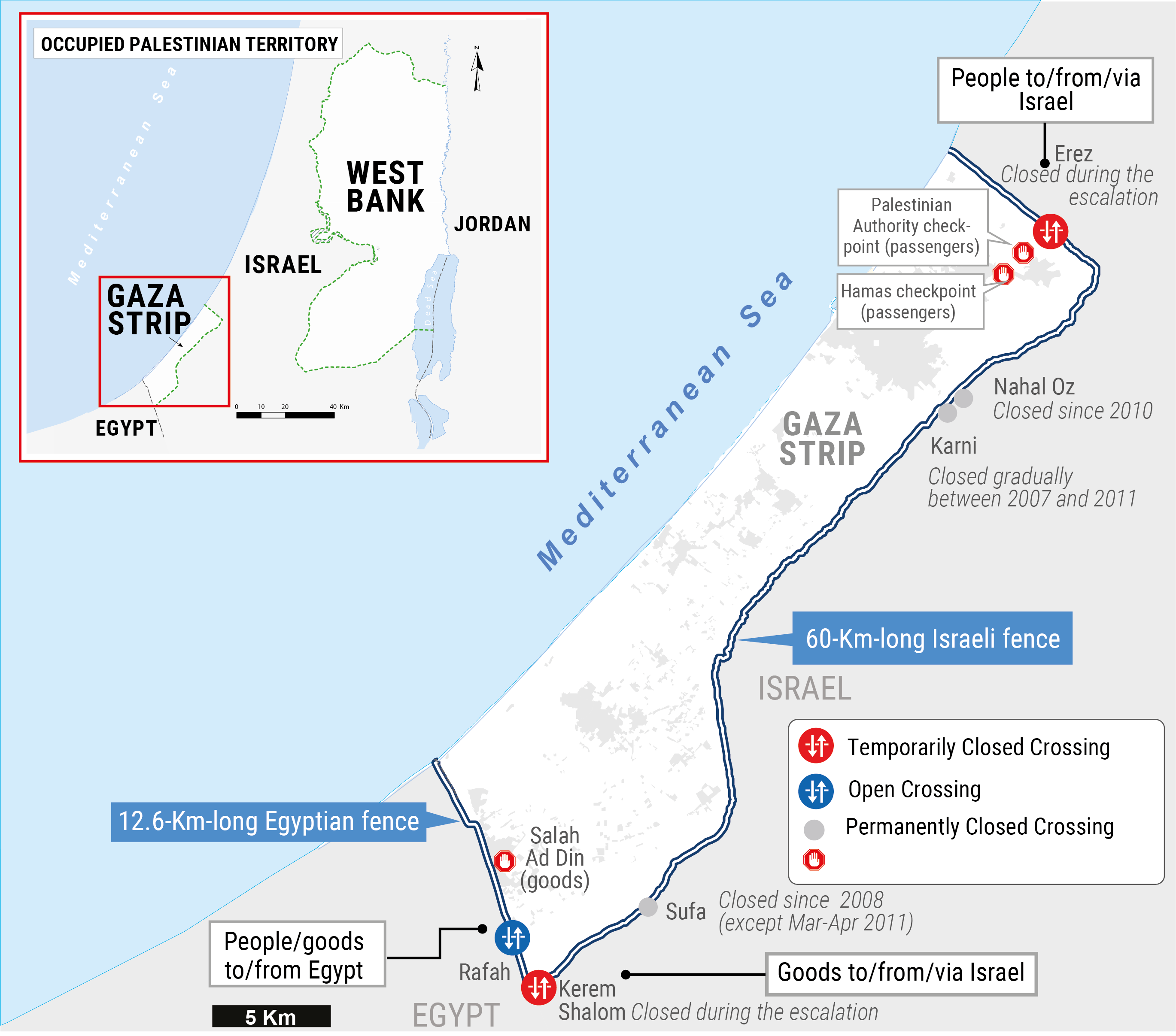Humanitarian situation in Gaza | Flash Update #5 as of 17:00, 15 May 2023
KEY POINTS
- The ceasefire in Israel and Gaza took effect at 22:00 on 13 May 2023, bringing to a halt the latest escalation of hostilities that began on 9 May 2023. It has largely held.
- In the Gaza Strip, the United Nations Human Rights Office (OHCHR) has verified 33 Palestinian fatalities from 9 to 14 May; one additional fatality is still under verification. Out of the verified fatalities, at least 12 were civilians. Among the 12 civilians were four girls, two boys, four women and two men. According to the Ministry of Health (MoH) in Gaza, 190 Palestinians were injured, including 64 children and 38 women.
- In Israel, one Israeli woman and one Palestinian worker from Gaza were killed and at least 40 physical injuries were reported by Israeli medical sources.
- On 14 May, Israeli forces began the gradual easing of the closure placed on Erez and Kerem Shalom crossings with Gaza since 9 May, allowing the movement of the commodities that were authorized prior to the escalation, including fuel.
- The Ministry of Public Works and Housing in Gaza reported that a total of 2,943 housing units sustained damage, including 103 destroyed, 140 severely damaged and 2,700 that were otherwise damaged. During the escalation, 1,244 Palestinians were internally displaced, either because they lived in one of the 2,943 housing units that were damaged, or because they identified safer areas to stay in. Initial reports indicate that 20 schools administered by the Palestinian Authority and six schools administered by United Nations Relief and Works Agency for Palestine Refugees in the Near East (UNRWA) were damaged to various degrees. Over the night of 12 May, airstrikes near health facilities resulted in partial damage to Al Aqsa hospital in Deir al Balah and the Indonesian hospital in northern Gaza, in addition to two primary health care clinics in Khan Younis and northern Gaza.
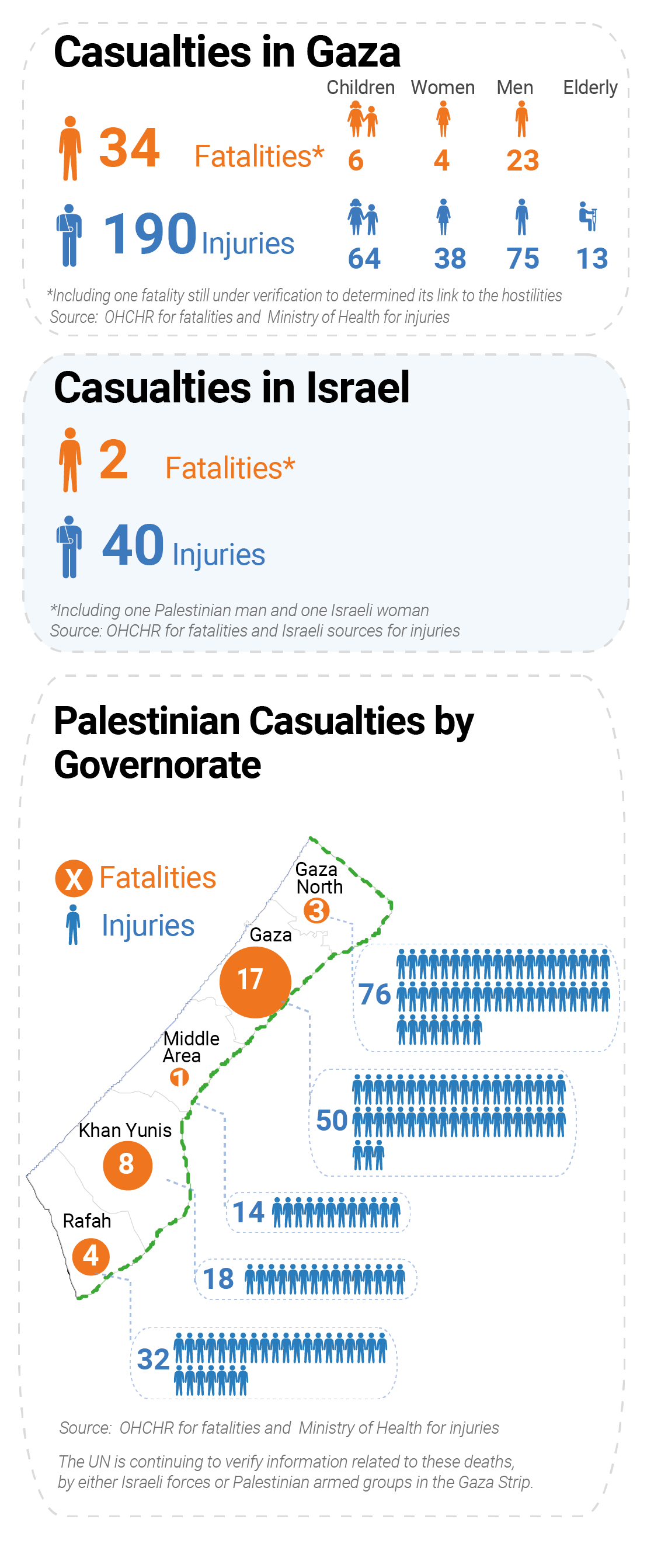
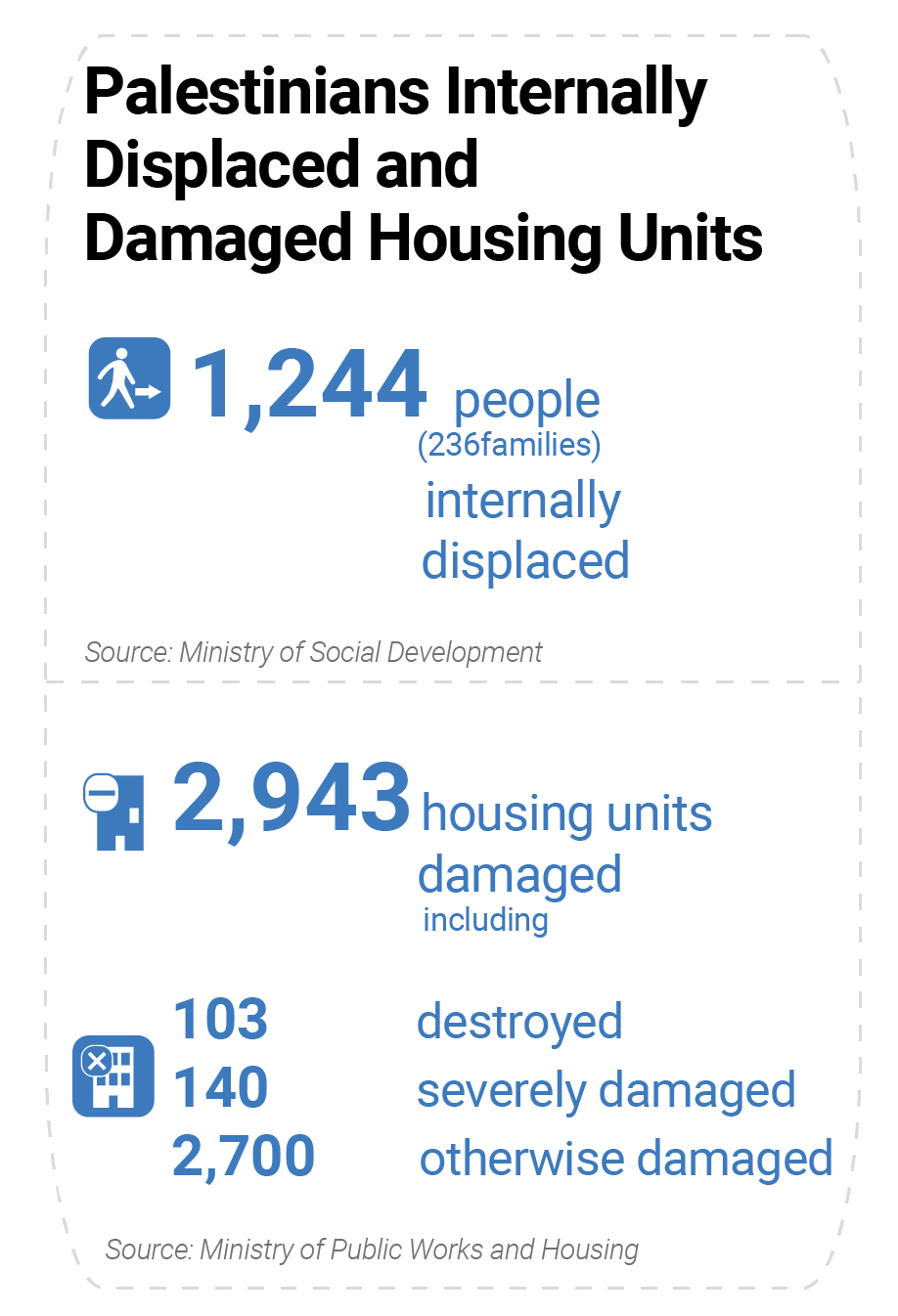
- The authorities in Gaza are fixing electrical lines as well as water and wastewater networks, and clearing roads, including the removal of rubble from damaged buildings. The local authorities’ explosive ordnance disposal teams have started removing unexploded ordnances. Markets and schools have reopened.
- Funding of the 2023 Humanitarian Response Plan is urgently needed, particularly in light of this escalation. A summary update to the Plan is being produced to reflect priorities in the aftermath of the latest hostilities.
SITUATION OVERVIEW
- On 9 May, Israeli forces launched a military operation in the Gaza Strip. Israeli airstrikes struck residential buildings and houses where three members of the Palestinian Islamic Jihad were staying, killing them along with ten family members. Palestinian armed groups in Gaza fired rockets from various locations towards Israel, with exchanges of fire continuing through 13 May.
- During the escalation, the Israeli military reported targeting 700 objectives in the Gaza Strip. According to the Israeli military, more than 1,400 rockets and other projectiles were launched by armed Palestinian groups towards Israel, with more than 1,100 reaching Israeli territory, and the rest falling short and landing in Gaza or in the sea.
- Throughout this period, the Israeli authorities closed the Erez and Kerem Shalom crossings, preventing the movement of people and goods from the West Bank or Israel and back. The closures affected humanitarian access, essential services, and the entry of vital items such as fuel. The Egyptian-controlled Rafah crossing and the adjacent internal Salah Ad Din gate, controlled by the local authorities, operated as usual, allowing the movement of goods and people between the Gaza Strip and Egypt.
- The hostilities continued until a ceasefire came into effect at 22:00 on 13 May. The ceasefire continues to largely hold, despite incidents involving the exchange of fire, shortly after the ceasefire and on 14 May.
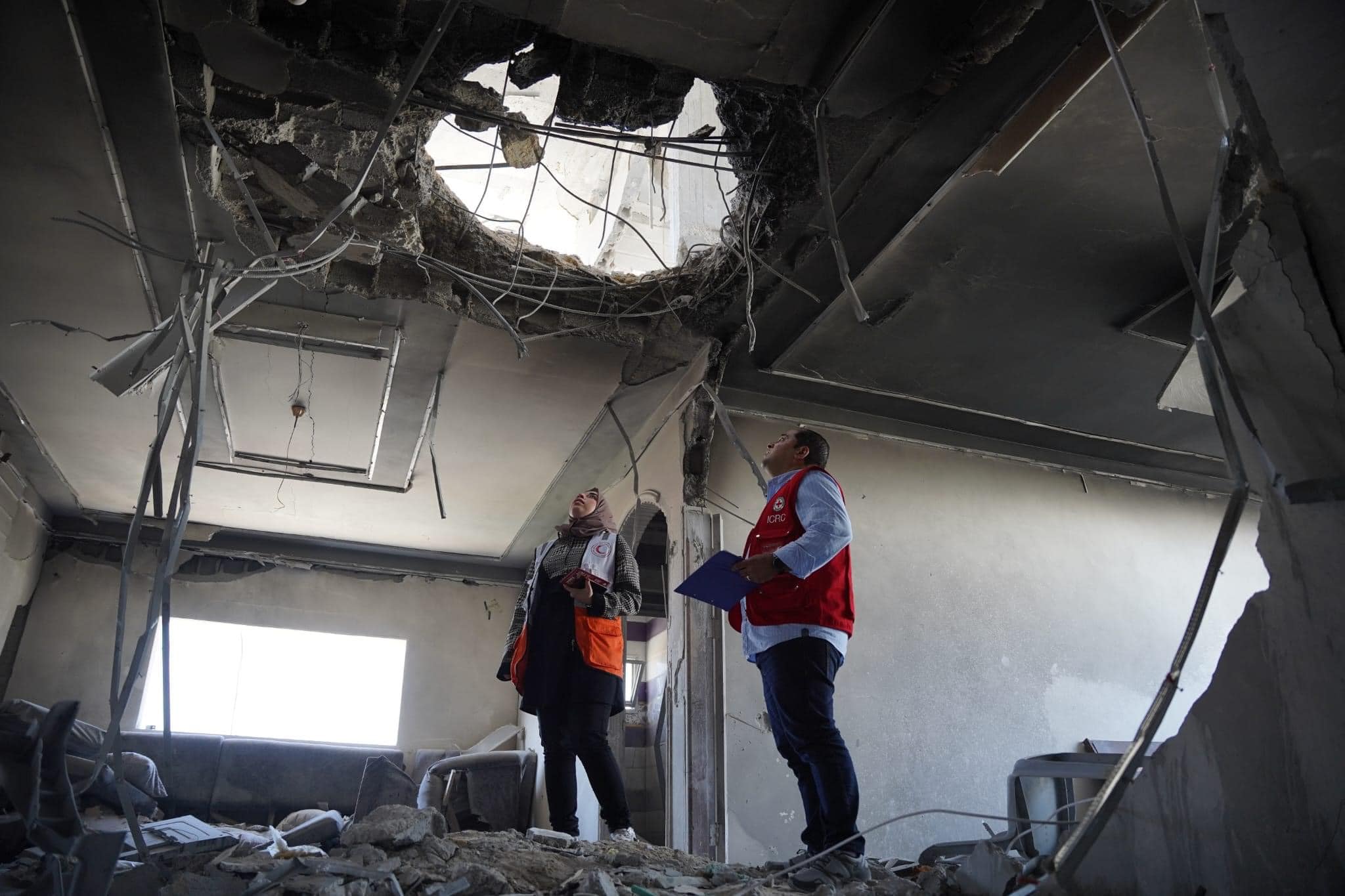
Initial assessment of damaged caused to a house during the escalation in Gaza. 13 May 2023. Credit Palestine Red Crescent Society
HUMANITARIAN OVERVIEW
- The escalation of hostilities resulted in casualties, displacement and infrastructure damage (see key points above). In addition, there has been a humanitarian impact on education, livelihoods, access to services, shelter and water and sanitation.
- The escalation and the associated closure of the Israeli-controlled crossings severely affected people’s access to essential services. For example, patients were unable to reach health facilities, including those who needed referral to hospitals in the West Bank, including East Jerusalem and schools were closed throughout the hostilities.
- Mental health and psychosocial support (MHPSS), gender-based violence (GBV) and child protection services hotlines continued to operate during the escalations and noted a relative increase in incoming calls indicating increased levels of stress, fear, anxiety, insecurity, and panic attacks as well as domestic violence especially among women and children. Responses will need to correspond to the rise in case management, stress relief activities, MHPSS responses, GBV responses and legal aid.
- The local authorities estimated losses related to the cessation of economic activity at US$40 million and infrastructure losses at about $1 million, including to 159 water lines and 173 sewage lines, 304 power lines and transformers, in addition to damage to roads.
- The damage to housing units is estimated at $9 million.
- The escalation exacerbated pre-existing shortages of urgent medical supplies needed for critical health services, including treatment for the wounded.
- According to the MoH in Gaza, hundreds of patients and their companions were unable to reach vital medical care in the West Bank, including East Jerusalem, or in Israel.
- The closure of Israeli crossings prevented the entry of vital items such as food. Since the beginning of the year, an average of 80 truckloads per day of food items had entered Gaza from or through Israel. Additionally, the closure prevented the dispatch of food supply by the World Food Programme (WFP), from Israel into Gaza.
- During the closure, fodder supplies reached critically low levels.
- Access to the sea for fishing was suspended for five consecutive days per safety directives from the local authorities, affecting more than 4,400 fishers and their families, who rely on fishing as their main source of income.
- Farmers were unable to safely access farmlands near the Israeli perimeter fence for irrigation, harvesting, feeding livestock and other essential activities, critically undermining their livelihoods, and leading to scarcity of fresh vegetables and other food commodities in local markets.
- The agricultural sector incurred losses estimated at $3 million, including 200 agricultural wells, 10,000 metres of irrigation lines, 600 dunums of crops (vegetables and fruits), and 150 dunums covered with greenhouses. Livestock farms, including poultry, cattle, and sheep, incurred losses estimated at $225,000, in addition to loss incurred due to the inability to transfer and export more than 1,100 tons of vegetables and fish.
- The Gaza Power Plant, which depends on regular fuel deliveries through Kerem Shalom crossing, had to shut down one of its three operating turbines between 10 and 15 May. This reduced electricity provision to around 12 hours per day, on average, disrupting the already challenged provision of basic services, including water, sanitation and health care causing larger reliance on backup generators and reducing access to piped water.
Protection against Sexual Exploitation and Abuse
All humanitarian responses will prioritize a community-centered approach and will take appropriate measure towards the protection against sexual abuse and exploitation (PSEA). SAWA helpline 121 and WhatsApp number 00 972 59-4040121 (East Jerusalem 1-800-500-121) operate 24/7. These toll-free numbers are disseminated across all areas of intervention to report cases of sexual abuse and exploitation and facilitate emergency counselling and referrals of affected people to services. The PSEA Network is monitoring calls daily and will reinforce the number of counsellors if necessary.
FUNDING
The escalation has highlighted the urgent need for humanitarian assistance in the occupied Palestinian territory (OPT). Of the total requirements of about $502 million outlined in the 2023 Humanitarian Response Plan, only 15 per cent has been funded in the first third of the year. Organizations such as UNRWA and WFP are facing critical funding shortfalls, resulting in decreased assistance to vulnerable Palestinians at a time of increasing need and heightened instability.
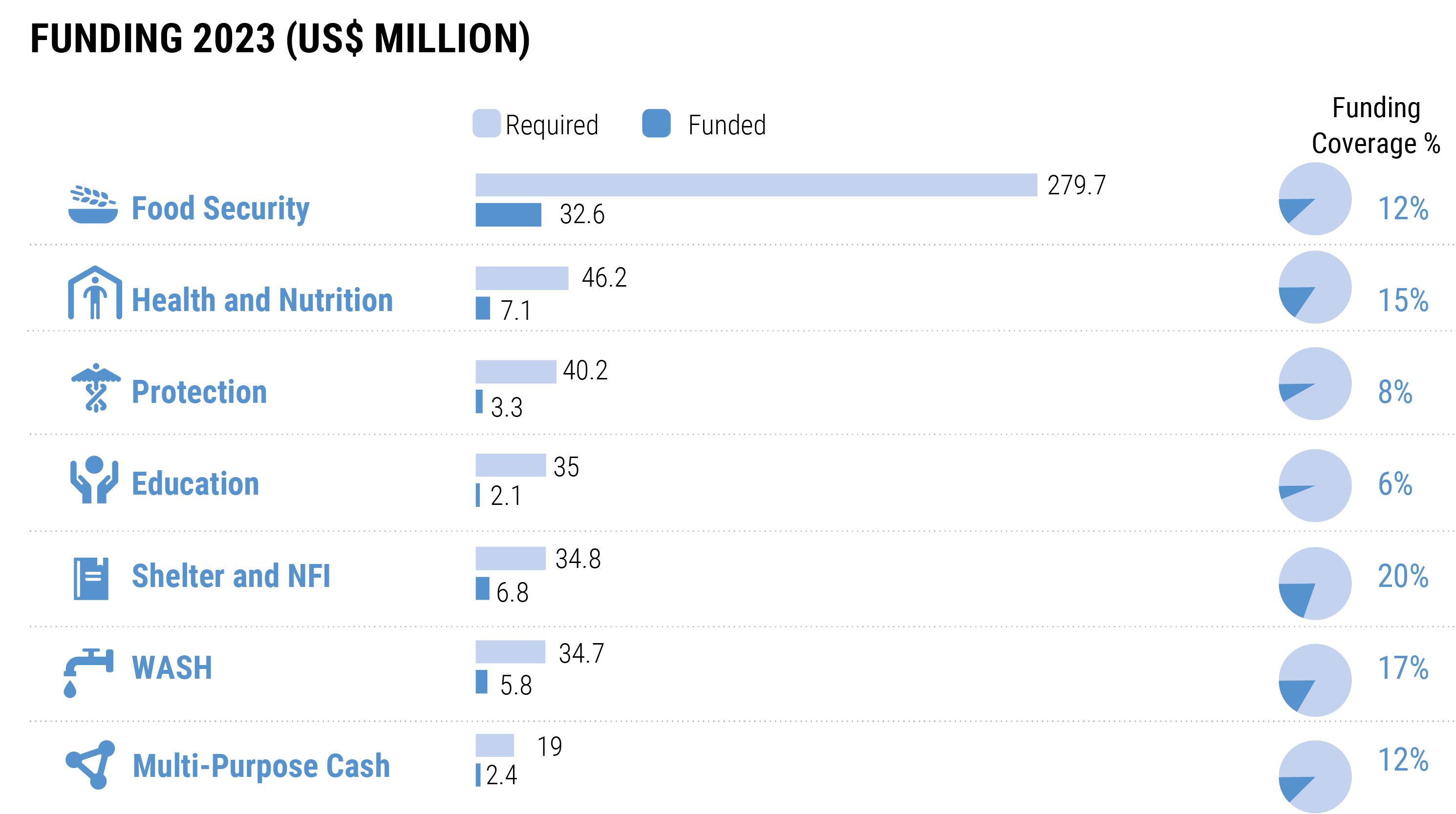
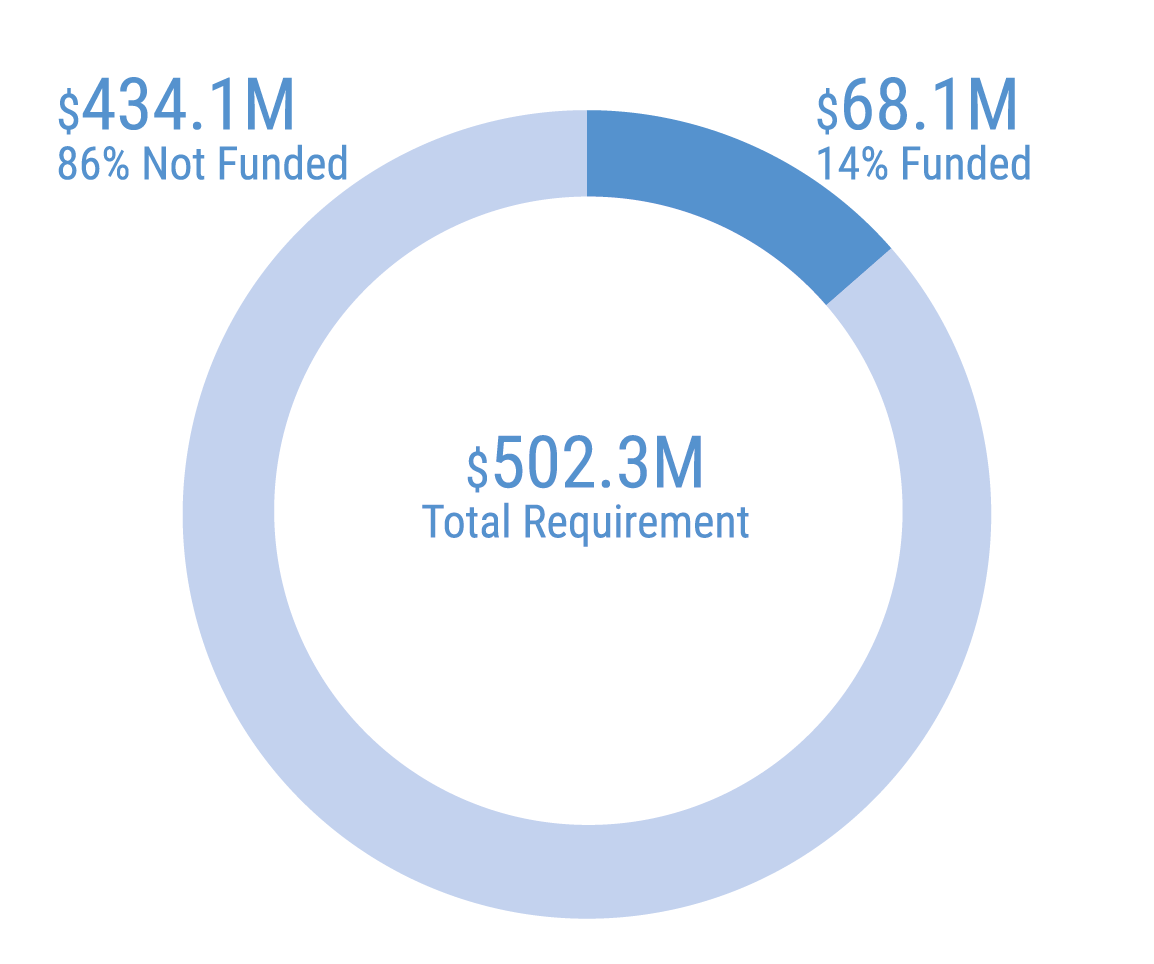
| Cluster/Sector | Required (US$) | Funded (US$) | Coverage (%) |
| Education | $34,962,875 | $2,054,849 | 5.88% |
| Food Security | $279,745,504 | $32,644,552 | 11.67% |
| Health | $46,157,000 | $7,129,533 | 15.45% |
| Multi-Cluster/Multi-Purpose Cash | $18,996,729 | $2,360,237 | 12.42% |
| Protection | $40,167,245 | $3,342,974 | 8.32% |
| Shelter and Non-Food Items | $34,848,993 | $6,800,000 | 19.51% |
| Water, Hygiene and Sanitation | $34,716,169 | $5,764,012 | 16.60% |
